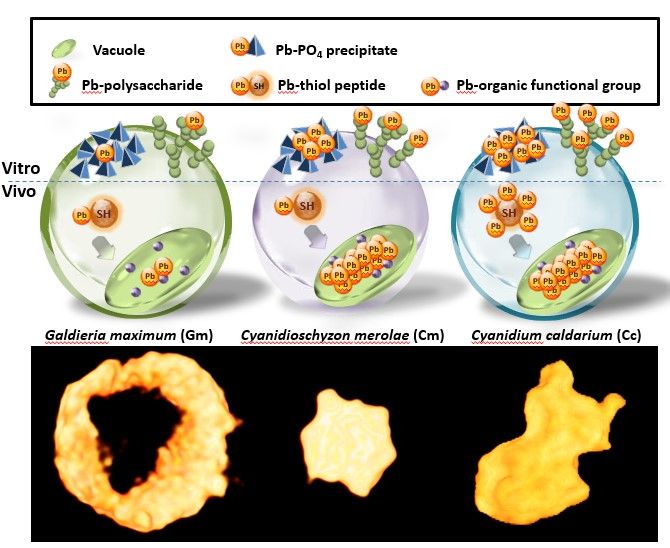新穎材料農業:友善環境農業新穎材料研發與安全評估【土壤環境科學系/鄒裕民特聘教授、劉雨庭副教授/優聘教師】
| 論文篇名 | 英文:Molecular mechanisms for Pb removal by Cyanidiales: a potential biomaterial applied in thermo-acidic conditions 中文:溫泉紅藻去除鉛的分子機制:應用在熱酸性條件下的潛力生物材料 |
| 期刊名稱 | CHEMICAL ENGINEERING JOURNAL |
| 發表年份,卷數,起迄頁數 | 2020, 401, 125828 |
| 作者 | Cho, Yen-Lin; Lee, Yao-Chang; Hsu, Liang-Ching; Wang, Chun-Chieh; Chen, Pin-Chen; Liu, Shao-Lun; Teah, Heng-Yi; Liu, Yu-Ting(劉雨庭)*; Tzou, Yu-Min(鄒裕民)* |
| DOI | 10.1016/j.cej.2020.125828 |
| 中文摘要 | 溫泉紅藻為能夠在高濃度金屬條件下之極端環境(20-56℃; pH 0.5-5.0)中生存,使其成為金屬修復的綠色材料。本研究為首次確定與三種溫泉紅藻[Galdieria maximum (Gm)、Cyanidioschyzon merolae (Cm)和Cyanidium caldarium (Cc)]有關的Pb(II)吸附能力和相關機制,測試的溫泉紅藻分別屬於三個不同的屬,而吸附機制是由鉛LIII-邊緣X光吸收光譜得到的物種變化、有機官能基變化、及由同步輻射光源操作的紅外線光譜所得的蛋白質二級結構變化之綜合結果推導,此外亦使用X光顯微攝影術拍攝3維影像。由光譜結果可歸納出四個溫泉紅藻抵抗鉛毒性的機制:無機鉛-磷酸沉澱、有機鉛錯合伴隨移動到液胞儲存、及與硫醇基之特殊螯合,其導致蛋白質二級結構瓦解。儘管這四個機制通常都會被執行來抵抗鉛毒性,但是可發現不同屬的溫泉紅藻對於單一機制的偏好。隨著鉛吸附濃度增加,Gm傾向以無機沉澱物來隔絕鉛,然而Cc卻顯現出獨特的鉛與硫醇基胜肽錯合。這個結果暗示鉛物種隨著吸附濃度的動態轉換,從無機沉澱轉換到有機錯合,尤其經由硫醇基鍵結,可大幅增加鉛的吸附量,這也可以解釋Cc的鉛吸附量(298.4 mg g-1)為Gm的八倍之多。本實驗得到的結果證實溫泉紅藻為一有潛力的綠色材料,推廣應用溫泉紅藻在環境復育上的可行性。 |
| 英文摘要 | Thermoacidophilic Cyanidiales are capable to survive in extreme environments (20-56 ℃; pH 0.5-5.0) with concentrated metals, allowing them to serve as promising green materials applied in metal remediation. It is the first attempt to determine the capacity and related mechanisms for Pb(II) ions sorption on three Cyanidiales genera: Galdieria maximum (Gm), Cyanidioschyzon merolae (Cm), and Cyanidium caldarium (Cc) in relation to changes in Pb speciation obtained from Pb LIII-edge X-ray absorption, organic functional groups, and protein secondary structures derived from synchrotron-based Fourier-transform infrared spectroscopy. Three-dimensional images of Cyanidiales were collected using Transmission X-ray microscopy. Lead tolerance on Cyanidiales was modulated according to four mechanisms: the defense line provide by polysaccharide, the inorganic Pb-PO4 precipitation, the organic Pb complexation concomitant with the transport to cell vacuoles, and the specific thiol-Pb chelation involved in disruption of protein secondary structures. Despite Cyanidiales generally performed all mechanisms against Pb toxicity, individual defense responses were highlighted by specific Cyanidiales species. The redistribution of Pb-polysaccharide species and inorganic Pb-PO4 precipitates toward organic complexation promoted Pb(II) ions sorption capacity of Cyanidiales, accounting for the almost eight-time-greater sorbed Pb (298.4 mg g-1) on Cc in comparison to Gm. The knowledge provided here could improve the application of the Cyanidiales in environmental remediation as an innovative green technology. |







